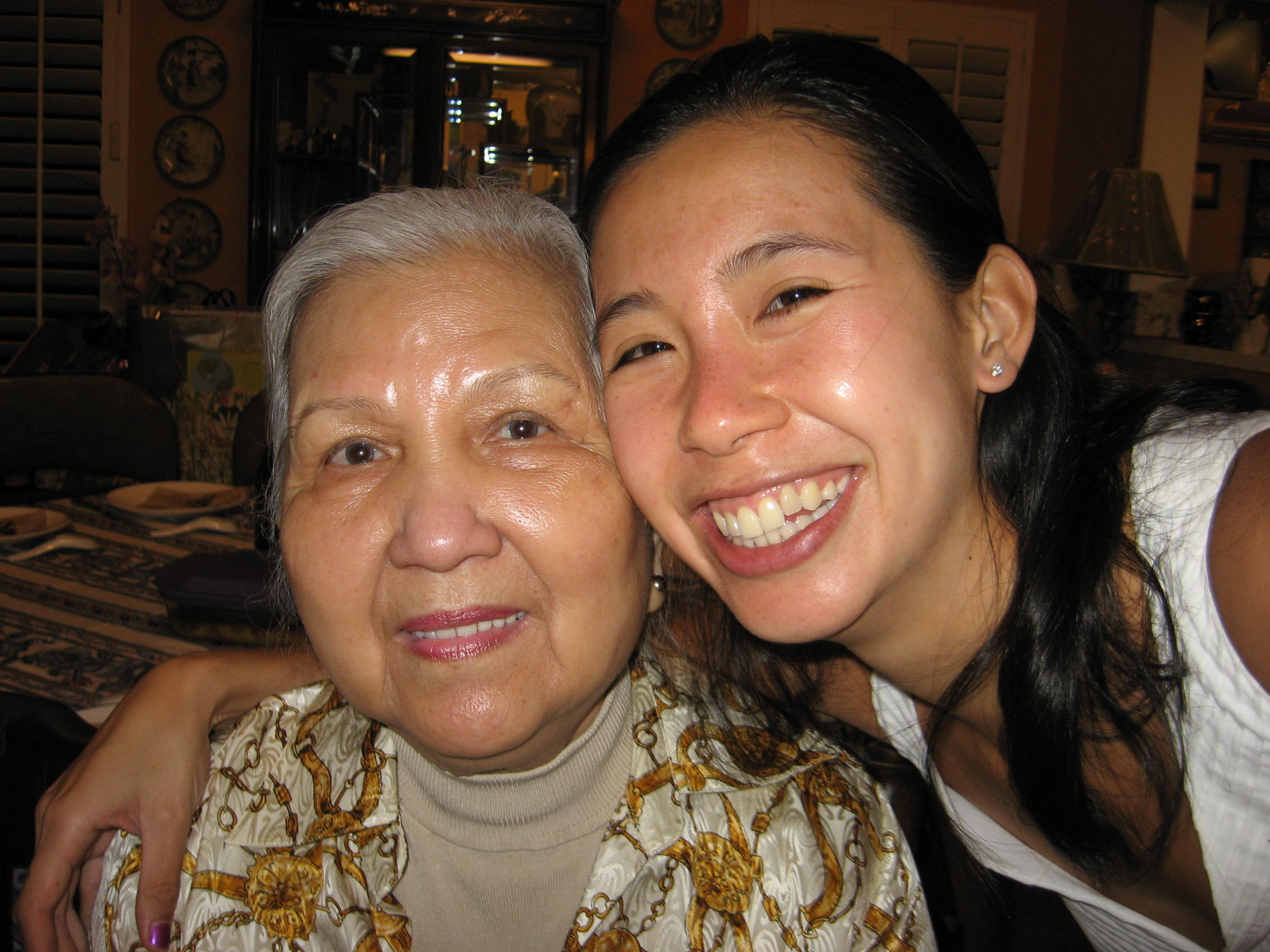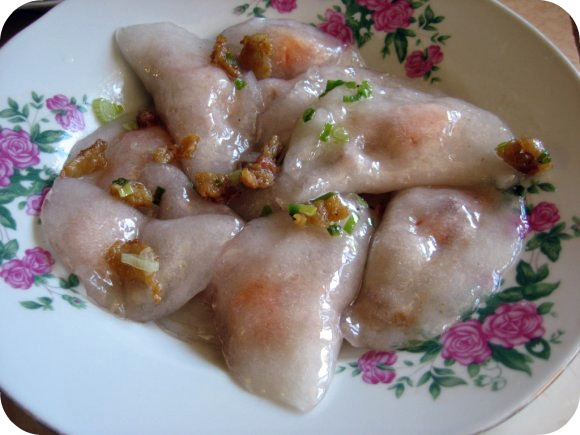10 Apr / In the Kitchen With …

I’m thrilled to debut a monthly guest column, “In the Kitchen with …” And who might the author be? Why you!
Many of us have spent time in the kitchen with grandma, whether just messing around with dough and shaping blobs while she makes yaki manju (Japanese bean cookies), or actually alerting our noses and our ears to the sizzle of spices in the wok. I’d like to dedicate this column to the shared experience of learning to cook with a beloved family member, be it grandma, mom, aunty, or even dad. I invite you to write a brief essay and contribute a recipe, photographs, or even a video, as a tribute to these wonderful people in your life. If you’re interested, please email me at pat@ediblewords.com.
I’d like to thank Cathy Danh of Gas-tron-o-my for being my first guest blogger. Enjoy!!
In the Kitchen with … Ba Ngoai
By Cathy Danh

Cathy and her Ba Ngoai
I’m a wuss when it comes to preparing Vietnamese foods from scratch. The fear of slaving over a meal that only vaguely resembles the homey dishes that I grew up on is overwhelming enough to send me running to the nearest Vietnamese restaurant.
When I cook Vietnamese food, I want nothing more than for it to taste like my Ba Ngoai (maternal grandmother) made it. If my seasonings are off or the texture isn’t just right, I consider the effort a big ‘ol failure.
For the past two years, I have been trying to get over my complex by learning how to prepare my family’s favorite recipes with Ba Ngoai.
Whenever I’m in San Diego for vacation or just a short visit, I pencil in an afternoon where I can soak in her culinary know-how. Sure, there are countless Vietnamese recipes online and in cookbooks, but what I strive for is the taste of home; in this regard only a tutorial from grandma will do.
Our lessons usually begin with a trip to a bustling Vietnamese grocery store. I love how demanding and picky she is when it comes to buying meat, fish, and produce. The men behind the counter know to only sell the best cuts to Ba Ngoai, lest they want to see her evil eye.
With our bounty in tow, we drive back to her home and start prepping and cooking. Like a lot of Asian grandmothers, Ba Ngoai cooks by feel. She doesn’t think in terms of tablespoons or cups, she just gracefully reaches into her pantry (and arsenal of experiences) for whatever seasonings will make the dish ‘just right.’ Ba Ngoai has taught me the power of nuoc mam (fish sauce), salt, sugar, and pepper. These four simple ingredients bring about incredible depth of flavor with minimal effort.
With each informal lesson, my confidence as a Vietnamese cook gets a boost. There’s a certain rhythm to Vietnamese cooking that’s starting to come naturally with each effort-sauté, season, braise, rest. Learning to cook with Ba Ngoai has demystified Vietnamese food for me, thus making it more accessible and much less intimidating. I’ve barely begun to scratch the surface of dishes I want to learn how to prepare, but with my grandmother’s basic tips and crafty tricks in hand; I know that I can master the art of Vietnamese cooking.
Ba Ngoai’s Bánh Bột Lọc (Shrimp and Pork-Stuffed Pouches)
Photo courtesy of Cathy Danh
Your mouth will be in for a surprise–the shrimp and pork filling is encased in a sticky and chewy skin made from tapioca starch that is toothsome and somewhat akin to gummy bears. Then it’s topped with green onions and crispy pork fat and drizzled with fish sauce. The result? A burst of textures and flavors probably unlike anything you’ve had before (unless you grew up eating this dish!). Cathy’s bà ngoại, Yen Ho, cooks the filling with the heads as well to impart an intense orangey color but you can omit them. But do leave the peels on–they give the dish flavor and crunch and also keep the shrimp moist and juicy. It’s all a matter of preference. If you do decide to leave the peels on, chew them thoroughly! (P.S. Visit Cathy’s blog for more pictures!)
Time: 2 hours
Makes: Makes 4 servings (24 pouches)
Filling:
12 (about 1/4 pound) medium shrimp, unpeeled
5 (about 1/4 pound) large shrimp with or without heads, unpeeled
1/4 pound pork belly with skin and fat
1 tablespoons canola or other neutral oil
1 1/2 teaspoons fish sauce
1 1/2 teaspoons sugar
1/2 teaspoon salt
1/2 teaspoon freshly ground pepper, or to taste
Dough:
2 cups tapioca starch
1 cup water
1 tablespoon oil, plus more for kneading
All-purpose flour for dusting
Topping:
4 ounces pork fat, diced into 1/4-inch cubes
3 tablespoons canola or other neutral oil
4 green onions, cut into thin rings
Fish sauce
To make the filling, remove the shrimps’ tails, legs (called pleopods or swimmerets) and veins, but leave their peels intact. Leave the heads on the large shrimp.
Cut pork into 1/2-inch strips and then cut crosswise into 1/4-inch slivers containing meat, fat, and skin. Set aside.
Preheat a dry 10-inch skillet over medium-high heat. Add pork and stir and cook for 2 minutes until the meat just loses its blush. Add oil, fish sauce, salt, sugar and shrimp. Stir and cook until shrimp is orangey-pink and all the liquid has been absorbed, about 3 to 4 minutes. Remove and discard the shrimp heads once they release their color. Sprinkle with black pepper, toss with one last flourish and take off the heat.
To make the dough, place the tapioca starch in a large mixing bowl. In a small saucepan, bring water and oil to a rolling boil. While stirring vigorously with a pair of chopsticks or a wooden spoon, gradually pour the boiling water into the bowl until the dough starts to pull away from the sides of the bowl and forms a sticky mass that is still pliable. (Tip: after pouring in half a cup of water, slow it down to a trickle at a time). You may not have to use up all the water. Be very careful during this process. One drop too many and the dough will be too wet and sticky to handle. If the mixture transforms into a pasty sludge (resembling thick Elmers glue), the water wasn’t boiling hot enough. If this happens, you’ll have to start all over again.
Cover with a damp cloth and set aside for 10 minutes or until dough is cool enough to handle. Rub oil on your hands and knead dough on a well-oiled surface for about 5 minutes until it is smooth and pliable.
Wipe down the work surface and dust with flour. Knead dough again for 1 to 2 more minutes until it is very smooth.
To assemble the pouches, divide dough into half and cover unused portion with a damp cloth. Working with one half of the dough at a time, pinch off 12 equal balls (about 1-inch across) and set aside in one corner of work surface. Cover with a damp cloth to keep dough balls from drying out as you work.
With a rolling pin, roll a ball into a flat, even disc about 3-inches in diameter. Place one shrimp and a piece or two of pork in the center and fold in half to form a half-moon. Pinch edges to seal. Set pouches in a single layer on an oiled tray and cover with a damp cloth. Repeat with the remaining dough and filling.
In a 3-quart saucepan, bring 6 to 7 cups water to a rolling boil. Prepare a big bowl of cold water. Gently lower 5 to 6 pouches into the water and cook for 2 to 3 minutes. (You can cook more or less pouches at the same time depending on the size of your pot just as long as they are floating freely in the water.) The pouches are done when they float to the surface, the skin is soft and supple, and the edges are turning translucent.
With a slotted spoon, lift out the pouches and dip immediately in the cold water bath to keep them from sticking to each other. After about 3 minutes, drain pouches again, shaking off as much excess water as possible, and set aside on a plate. The pouches should be completely translucent with the orangey-pink shrimp showing through. Repeat until all the pouches are cooked.
Preheat a small dry skillet over medium heat. Add pork fat and stir and cook continuously until pork fat is golden brown and crispy, about 8 to 10 minutes. Cover with a splatter guard to prevent oil from jumping out. Watch carefully and adjust the heat if pork fat starts to burn. When done, drain rendered liquid fat and discard. Reserve the crispy pork fat pieces.
In the same skillet, add oil and stir in green onions. Stir and cook for about 30 to 45 seconds until green onions turn bright green. Add reserved crispy pork fat and toss together until well mixed.
Divide pouches among 4 serving plates and top with the crispy pork fat mixture. Drizzle with fish sauce to taste and serve immediately.
Pat’s notes:
Getting the dough right takes some practice. There’s a very fine line between perfect and pasty. But don’t be disheartened, just keep trying and eventually you’ll get it! When my dough got pasty, I tried to remedy the situation by heating the mixture in a wok over medium heat. I added water a little at a time and the dough gradually came together to form the right consistency.
As grandma always says, please share!

















These look fantastic – and the crispy pork fat on top, mmmmm. Thanks for sharing the recipe!
they look so tasty!
wow, the recipe sounds very labor intensive, I’m much happier reading about it than trying to make them myself! A great story about learning to cook from the family matriarch. Cathy’s Gastronomy blog is one of my favorite reads too.
Hi Foodhoe, Cathy’s great! I hope to get more cooking stories from readers.
Wow, those look amazing, although I’m not sure I’m brave enough to try to make them! I’m from San Diego, where does your Ba Ngoai shop?
Hi Annalisa,
They’re a little intimidating, I must admit. But when you crave something, a childhood snack or THAT DISH you had on a summer trip to Vietnam, you must try to make it!
Annalisa – My Ba Ngoai shops at Vien Dong (5382 University Avenue, San Diego, CA 92105).
In the Kitchen With sounds like a great idea!
We do In the Kitchen With each Friday at designspongeonline.com featuring designers’ and creative professionals’ favorite recipes. You should take a spin around the column and see if you like it!
best
k
Hi 3LC,
Thanks for letting me know about In the Kitchen With at designspongeonline.com. I love the Web site! Great minds think alike eh?
Great recipe! But nothing better than learning from someone who has been doing it. Learning handed down recipes is so great.
love you grandma sounds great
Thanks, Chris! I’m sure I could say the same for everyone’s grandma.